SPORTS YOKOHAMA Vol.29:Feature01
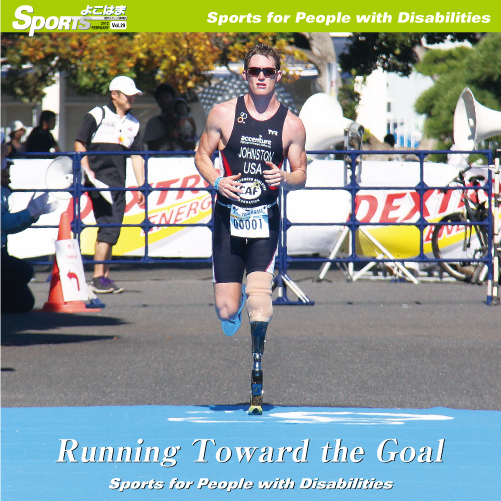
There are various forms of sport for people with disabilities. Participants in competitions are grouped in classes according to the degree of disability to ensure they can compete on equal terms, and special equipment and rules are available for more people with disabilities to enjoy sports. There are also rehabilitation sports for medical purposes.
In Yokohama City, a group led by Yokohama Rapport, a sports and cultural center for the disabled, is working together with sports associations, professional sport teams and volunteer organizations to promote the health and social participation of people with disabilities and their interaction with non-disabled city residents.
We interviewed several people who enjoy an active lifestyle by incorporating sports in their daily life despite physical handicaps. Oozing from their words is their feeling that sports are fun.
The interviewees encourage everyone to enjoy sports in pursuit of their own goal.
This volume of Sports Yokohama features these wonderful athletes.
Information provided by: Yokohama Rapport (Yokohama Rehabilitation Foundation) and Nissan Cup Executive Committee
Researched and written by: Keiji Nakamura (Yokohama Sports Association)

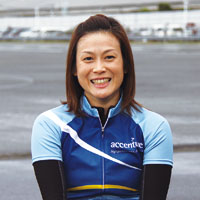 At the age of 24, Kazumi Nakayama suddenly suffered spinal cord infarction, a serious illness, which left her legs paralyzed.
At the age of 24, Kazumi Nakayama suddenly suffered spinal cord infarction, a serious illness, which left her legs paralyzed.
Now, Ms. Nakayama is a track and field athlete who participates in wheelchair marathons and other sporting events with a cheerful smile and a positive attitude.
We interviewed her to find out how she felt about taking part in competitions.
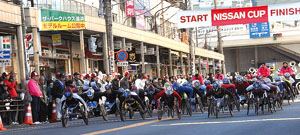
In the half-marathon race (21.0975 kilometers) of the 2011 Nissan Cup Oppama Championship, Ms. Nakayama finished second after Ms. Wakako Tsuchida, who has unofficially been given a berth in the wheelchair marathon of the London Paralympics.
I started doing wheelchair marathon racing when someone encouraged me to try it at the Kanagawa Rehabilitation Center where I was a visitor. At first, I thought it was a tough sport. But, these days I enjoy wheelchair marathons more as I make friends with good race mates and reduce my times. Now I have a balance between work and my competitive career, and I think that the support of many people has helped me reach where I am. Ever since I started to use a wheelchair, I’ve become more sensitive to the kindness of people around me.
Before I developed the disease, I loved playing basketball and surfing. My legs went numb because of the disease, but I managed to get over it. Now, I accept what I am and intend to do everything I can. I think I’m going to try new things both at work and in my competitive career.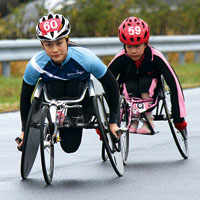 My goal for now is to participate in the 400-meter and 800-meter events in the Paralympic Games, which will be held in London this year. Although I have posted the A standard mark, I’m ranked below eighth place in the world rankings(*), which are used as selection criteria in Japan. So I need to achieve good results in the three upcoming events, which are the Kyushu Challenge Track and Field Championships in March, International Track and Field Meet to be held in Switzerland in May and Japan athletics Championships for the Disabled in June.
My goal for now is to participate in the 400-meter and 800-meter events in the Paralympic Games, which will be held in London this year. Although I have posted the A standard mark, I’m ranked below eighth place in the world rankings(*), which are used as selection criteria in Japan. So I need to achieve good results in the three upcoming events, which are the Kyushu Challenge Track and Field Championships in March, International Track and Field Meet to be held in Switzerland in May and Japan athletics Championships for the Disabled in June.
There are no Japanese runners in my class who run faster than I do, so I’ll focus on competing with foreign runners in the international race in Switzerland.
My ultimate goal as a competitive runner is to win a medal in the Paralympic Games to be held in Rio De Janeiro in 2016. Until then, I want to keep improving my record.
Nissan Cup Oppama Championship
The Nissan Cup has been held since 2000 through the collaboration of the Oppama Plant of Nissan Motor Co., Ltd., local residents and supporting organizations for the purpose of promoting sports for the disabled and local revitalization. The main event being a road race in which Paralympic medalists and other national top runners participate, this all-round wheelchair track and field meet features many events including those in which children with disabilities can take part as well as workshops and exchange meetings intended for local residents and elementary school pupils to learn about wheelchairs. Over 200 runners participate in the Nissan Cup.
Events: 2.5-kilometer race, 5-kilometer race, 10-kilometer race, half-marathon race (21.0975 kilometers), and challenge race (7.0325 kilometers)
* In all these events except the 2.5-kilometer race, racers (racing wheelchairs) are used.
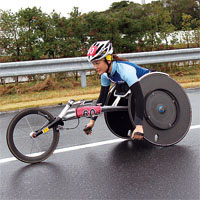
In wheelchair races, runners use a special wheelchair, called a racer, which is lightweight (approximately 5 to 8 kilograms) and features a frame structure designed to reduce air resistance. Runners are classified according to the type and degree of disability and the athletic function. Runners with spinal injury or transection are given classifications T51 to T54.
Records in the world rankings(*) 400 meters for T53 class women 800 meters for T53 class women Record of the No. 1 runner 00.56.40 01.51.95 Record of the No. 8 runner 00.58.08 01.56.74 Record of Ms. Nakayama (world ranking) 01.04.25(15) 02.09.25(13)
* The numbers of the world rankings are those available as of December 31, 2011.

There are various forms of sport for people with disabilities. Participants in competitions are grouped in classes according to the degree of disability to ensure they can compete on equal terms, and special equipment and rules are available for more people with disabilities to enjoy sports. There are also rehabilitation sports for medical purposes.
In Yokohama City, a group led by Yokohama Rapport, a sports and cultural center for the disabled, is working together with sports associations, professional sport teams and volunteer organizations to promote the health and social participation of people with disabilities and their interaction with non-disabled city residents.
We interviewed several people who enjoy an active lifestyle by incorporating sports in their daily life despite physical handicaps. Oozing from their words is their feeling that sports are fun.
The interviewees encourage everyone to enjoy sports in pursuit of their own goal.
This volume of Sports Yokohama features these wonderful athletes.
Information provided by: Yokohama Rapport (Yokohama Rehabilitation Foundation) and Nissan Cup Executive Committee
Researched and written by: Keiji Nakamura (Yokohama Sports Association)

 At the age of 24, Kazumi Nakayama suddenly suffered spinal cord infarction, a serious illness, which left her legs paralyzed.
At the age of 24, Kazumi Nakayama suddenly suffered spinal cord infarction, a serious illness, which left her legs paralyzed.
Now, Ms. Nakayama is a track and field athlete who participates in wheelchair marathons and other sporting events with a cheerful smile and a positive attitude.
We interviewed her to find out how she felt about taking part in competitions.

In the half-marathon race (21.0975 kilometers) of the 2011 Nissan Cup Oppama Championship, Ms. Nakayama finished second after Ms. Wakako Tsuchida, who has unofficially been given a berth in the wheelchair marathon of the London Paralympics.
I started doing wheelchair marathon racing when someone encouraged me to try it at the Kanagawa Rehabilitation Center where I was a visitor. At first, I thought it was a tough sport. But, these days I enjoy wheelchair marathons more as I make friends with good race mates and reduce my times. Now I have a balance between work and my competitive career, and I think that the support of many people has helped me reach where I am. Ever since I started to use a wheelchair, I’ve become more sensitive to the kindness of people around me.
Before I developed the disease, I loved playing basketball and surfing. My legs went numb because of the disease, but I managed to get over it. Now, I accept what I am and intend to do everything I can. I think I’m going to try new things both at work and in my competitive career. My goal for now is to participate in the 400-meter and 800-meter events in the Paralympic Games, which will be held in London this year. Although I have posted the A standard mark, I’m ranked below eighth place in the world rankings(*), which are used as selection criteria in Japan. So I need to achieve good results in the three upcoming events, which are the Kyushu Challenge Track and Field Championships in March, International Track and Field Meet to be held in Switzerland in May and Japan athletics Championships for the Disabled in June.
My goal for now is to participate in the 400-meter and 800-meter events in the Paralympic Games, which will be held in London this year. Although I have posted the A standard mark, I’m ranked below eighth place in the world rankings(*), which are used as selection criteria in Japan. So I need to achieve good results in the three upcoming events, which are the Kyushu Challenge Track and Field Championships in March, International Track and Field Meet to be held in Switzerland in May and Japan athletics Championships for the Disabled in June.
There are no Japanese runners in my class who run faster than I do, so I’ll focus on competing with foreign runners in the international race in Switzerland.
My ultimate goal as a competitive runner is to win a medal in the Paralympic Games to be held in Rio De Janeiro in 2016. Until then, I want to keep improving my record.
Nissan Cup Oppama Championship
The Nissan Cup has been held since 2000 through the collaboration of the Oppama Plant of Nissan Motor Co., Ltd., local residents and supporting organizations for the purpose of promoting sports for the disabled and local revitalization. The main event being a road race in which Paralympic medalists and other national top runners participate, this all-round wheelchair track and field meet features many events including those in which children with disabilities can take part as well as workshops and exchange meetings intended for local residents and elementary school pupils to learn about wheelchairs. Over 200 runners participate in the Nissan Cup.
Events: 2.5-kilometer race, 5-kilometer race, 10-kilometer race, half-marathon race (21.0975 kilometers), and challenge race (7.0325 kilometers)
* In all these events except the 2.5-kilometer race, racers (racing wheelchairs) are used.

In wheelchair races, runners use a special wheelchair, called a racer, which is lightweight (approximately 5 to 8 kilograms) and features a frame structure designed to reduce air resistance. Runners are classified according to the type and degree of disability and the athletic function. Runners with spinal injury or transection are given classifications T51 to T54.
Records in the world rankings(*) 400 meters for T53 class women 800 meters for T53 class women Record of the No. 1 runner 00.56.40 01.51.95 Record of the No. 8 runner 00.58.08 01.56.74 Record of Ms. Nakayama (world ranking) 01.04.25(15) 02.09.25(13)
* The numbers of the world rankings are those available as of December 31, 2011.
 ハマスポ
ハマスポ
 お知らせ&トピックス
お知らせ&トピックス ページトップへ戻る
ページトップへ戻る ページトップへ戻る
ページトップへ戻る

